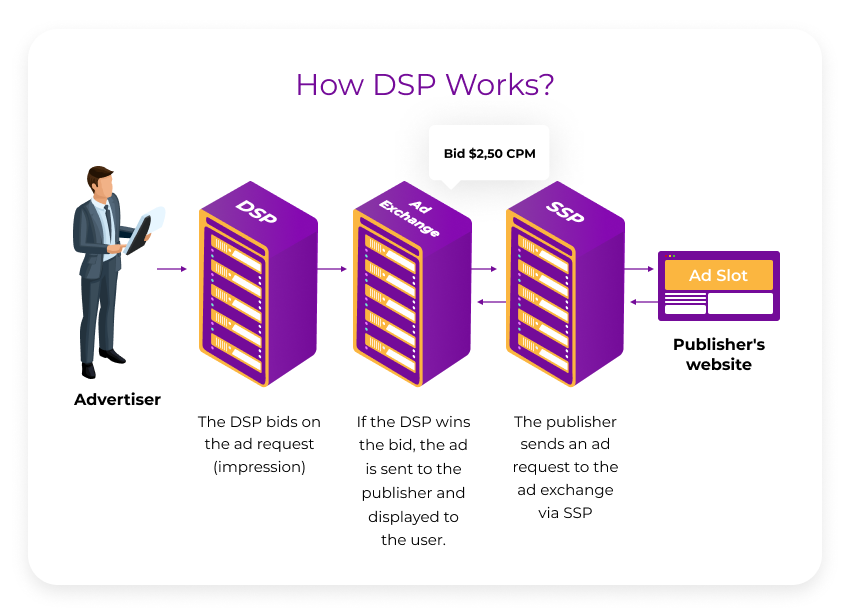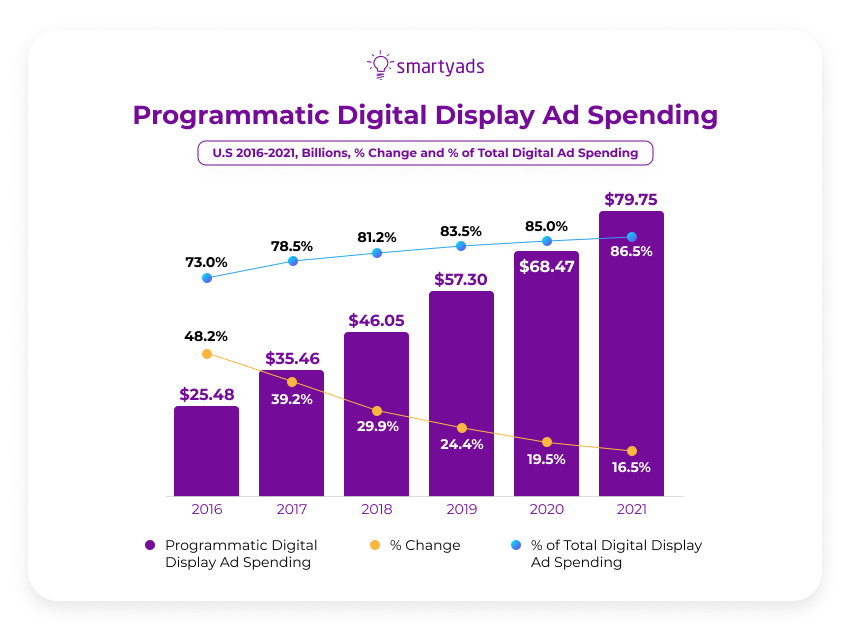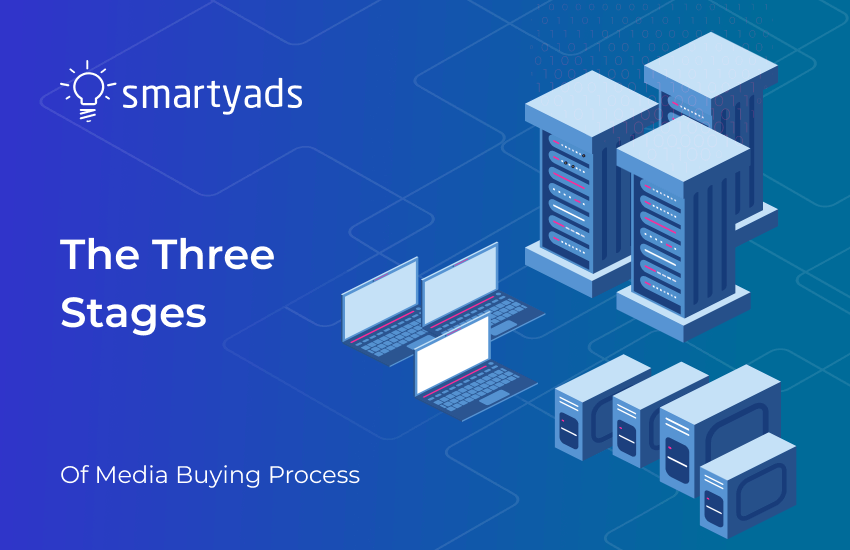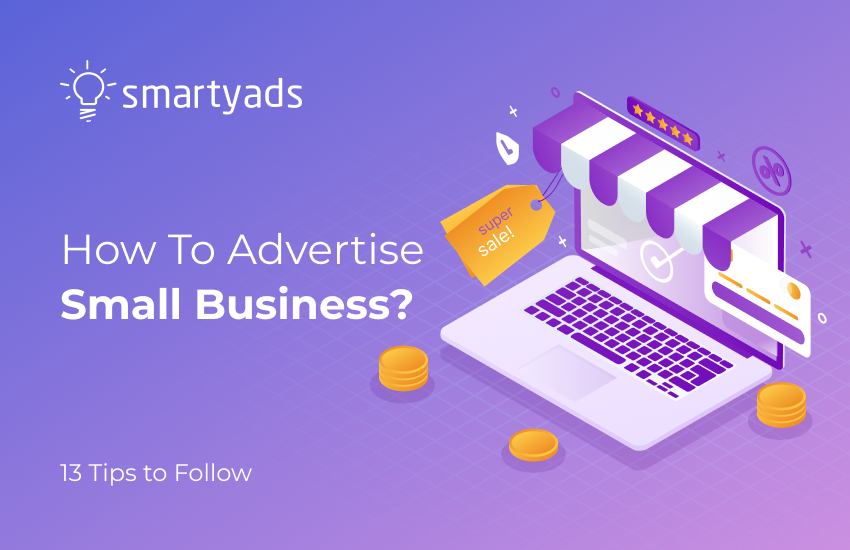Digital media buying is much more than creating an appealing banner or buying ad space. A brand might design the most brilliant ad in the world, but it would be totally worthless if nobody sees it. And you don’t just need any old audience to see the ad; you need the people who are most likely to be interested — your target group — to see it.
"Creative without a strategy is called ‘art’. Creative with a strategy is called ‘advertising’".— Jef I. Richards
Successful advertising doesn't only depend on what is shown and how, but also on where it is displayed and to whom it is addressed. For this reason, digital media buying and media planning are incredibly important.
The place where the ad appears determines the outcome of the entire advertising campaign and either bring the revenues to media buyers or leaves them penniless.
So, how to make great revenues out of your advertising campaigns while spending less money and time on managing and optimization? Let's find out!
What Is Media Buying Process?
Media buying process is a set of strategic wholesale multi-platform ad space purchases, negotiations, and arrangements aimed at finding the most advantageous ad placement at the lowest price for the period. Media buying can be done manually with media planning specialists or with third-party technology advertising platforms that automate the process.
Media buying falls into the paid media category and generally means the procurement of media space and time for displaying ad creatives. It is more than just the selection of ad placements - it involves a lot of media planning.
The process of buying media
When you buy media, the goal is to find the right place, time, and context to deliver relevant ads to the target audience and increase conversion rates, sales, or brand awareness. At this stage media planning is essential.
Digital media buying is time-based, meaning the buyer is paying for "renting" all possible ad placements on all possible platforms. So they must be available for the timeslot when it is convenient for the media buyer to bid for ad placement and place the ad.
Now let's review the media buying steps one by one.
Pre-launching
Advertising decisions related to media buying are not made overnight. In fact, the stage of meticulous preparation is the most time-consuming and presupposes in-depth research and careful media planning. In the pre-launch phase, the media buyer considers and makes relevant media choices.
The core focus for media buyers is to ensure that the selected media outlets align with advertising objectives.
“Advertising people who ignore research are as dangerous as generals who ignore decodes of enemy signals.” — David Ogilvy
Identify Target Audience
First, media buyers should get a clear picture of the existing customers, and investigate who they are. Media planners should clearly understand what audience they should target.
Distribute your audience into segments such as demographics (age, gender, social and marital status), geolocation (area, city, country), behavior (interests, hobbies), and other groups to understand with whom you are dealing.
Reach the audience
After getting to know your audience, try to find similarities and patterns to get an idea of the audience or people who may be interested in your product or service. After identifying the target group, think about the way to reach those people. Where do they go? How do they shop? Do they buy online or come directly to the venue?
If you plan to advertise online, think about media channels to reach potential customers: search engine ads, website, blog advertisements, and social network platforms. Make sure you know what platforms and devices your target group uses.
Research Competitors
Here media buyers should investigate potential competitors, and get a feel of their digital media buying strategy. Identify where your competitors advertise, whom they target, what worked, and what didn’t work for them.
Make market research for conducting correct media planning. Learning from rivals’ experiences will save time and allow you to create smart advertising campaigns from the beginning.
Design Media Buying Strategy
Choose forms of advertising that correspond to your campaign goals: print ads in newspapers and magazines; video commercials on TV, online, and movie theaters; indoor posters and outdoor billboards; radio advertising; banner and text media; mobile advertising, and so on.
Choose channels
Media buyers may opt to concentrate on one channel or buy media from different media owners. They may buy ad space simultaneously online, through radio, on TV, social media, or any other third-party media.
However, this might be a bit challenging — for every media channel, there must be a personally tailored message that fits that specific channel. If media buyers prefer to advertise online, they must understand how programmatic media buying works and get to know the basics of real-time bidding.
Choose Media Outlets
Now is the time to think through media planning strategy. Whether you cooperate with radio stations or newspaper publishers, it is important to negotiate the price of the media ad placements beforehand. Look for the best deals, and ask for discounts or bonuses that media vendors are ready to give. On a social media contact the influencers and negotiate the deal directly.
Track competition
Compare offers from multiple publishers, and don’t be afraid to negotiate the price before media buying. If you buy media, discuss with the demand-side platform (DSP) provider its platform fees and service costs, and make sure there are no hidden fees. Here on the demand-side platform, you can adjust the programmatic budget by setting the daily or monthly limits.
Allocate the Budget
After identifying precisely to whom to advertise, where, and how to buy ad space, it’s time for media planners to get their hands wet with programmatic buying. Set a target return on investment that you would like to achieve. Allocate a campaign budget according to the results you expect to achieve (clicks, conversions, sales completes, sign-ups, etc.).
Estimate expenditures
Before buying media you should also estimate expenditures for a specific period, such as day, month, or quarter marketing budget. Think about how to distribute your budget across ad placement channels — offline and online.
For online advertising select the suitable payment model - cost per mille or pay per click. Plan every dollar you spend on ad space and don’t forget to account for unforeseen expenses.
Campaign Launch
Now that you're done with media planning, it is time for the campaign launch. During the launch phase, the main responsibility of the media buyer is to ensure effective media delivery and constant monitoring of the ad performance or campaign performance.
At this stage, it is crucial for media buyers to analyze what works and what doesn’t and, based on those insights, make further decisions.
Ensure Media Delivery
As a media buyer, you must make sure the advertisement appears in the desired location, in front of the audience, and in the right context. Make sure to deliver highly relevant messages that bring value to consumers instead of disturbance or irritation. make sure you've picked the right ad space. Track the progress and the customer engagement after media buying.
Respond to Customer Behavior or Competitor Activities
Sometimes potential customers don’t interact with the advertisement as planned, and you don’t receive the desired response (clicks, buys, signs up, calls, etc.). In this case, be ready to adapt and change the strategy according to consumer feedback. Furthermore, track the performance of your competitors, and always be aware of industry trends.
Revise
Attention! Don’t be afraid to adjust the settings, budget, and/or media outlets during the campaign. Set up deadlines for reassessment. Be ready to review periodically throughout the campaign, and always re-evaluate the original plan and strategy. If you find that the results are not meeting the initial objectives, be flexible and adapt quickly.
Post-launch Reflections
The post-campaign stage is a time to reflect and think about the good, the bad, and the ugly of the advertising campaign in terms of delivery, media space, return on investment, customer engagement, and overall performance.
Here it is important for media buyers to make the right conclusions. This way you will draw valuable insights for your future media planning strategy.
Analyze the Effectiveness of the Campaign
Collect as much data as possible, and review statistics and granular reports to see the strong and weak points of the campaign.
Analyze the effectiveness of the media space and whether it generated revenues that were expected. Check how the audience interacted with the product, and assess consumer behavior. Evaluate the return on investment, and mark errors that have been made to avoid them in future advertising campaigns.
Collect Data
When you have all the data, it is time to use it. In digital advertising, data is used to build algorithms that help optimize advertising campaigns and provide better targeting. Data is a marketer’s best friend, so look at it carefully. Aggregate data, and look for major and minor trends.
Draw Insights
Don’t look at singular points, especially when they change the direction. Search for relationships among variables or correlation and dependence patterns that help understand the logic.
Finally, look at the data from different angles. Invite others to examine the data and discuss your impressions.
Automating media-buying with programmatic
All described stages of media buying can be automated with programmatic platforms that deliver ads to the right audience at the right time. Let's see how exactly programmatic ad serving is happening and why DSPs can be so much better for advertisers than manual media purchasing.
How to start with programmatic buying?
With programmatic DSP an advertiser, marketer, or media buyer can buy online media without going through all traditional time-consuming stages of media buying.
Ad placement, campaign management, and optimization - everything is happening in real-time and almost with no human intervention. All a marketer or an advertiser needs is to create a free account on DSP and fill in the budget that is planned to be spent during the campaign.
After this, the system will automatically select and fill the right ad placements that match the campaign's criteria of the advertiser. The system will select only those impressions that can be potentially interesting and relevant to the viewer which increases the likelihood of conversion. This way media buying and media planning get completely automated.
How to correctly set up the campaign criteria?
Set up DSP campaign
On SmartyAds DSP media buyers can choose the ad campaign type they want to run as there are plenty of digital ad formats. After that basic campaign settings should be selected. media buyers can also configure targeting up to 30+ targeting options, or launch a retargeting campaign.
Targeting
Planning to show ads only to 30-40-year-old people who live in the New York area or those who live in Italy and use IOS gadgets? This is all possible automatically with DSPs targeting.
In the same dashboard, media buyers can choose the daily spend limit, configure frequency capping, and dayparting (exact hours and days when ads will be shown during the campaign). With white and blacklists, it is possible to target only specific ad inventory (or exclude particular sources from the list).

When the campaign settings are filled it's time to download the creative ad unit. As soon as the creative gets approved by the platform moderation team, the campaign is officially activated, and the automatic media buying is started.
The mechanism of ad serving on DSP
Let's take a closer look at how DSPs work. DSPs belong to the vast programmatic advertising ecosystem which includes connected SSPs (automatic ad selling platforms for publishers) and ad exchanges. This giant network of connected platforms enables media buyers to reach publishers and organize ad placements all across practically any geos.
How does it happen?
In a nutshell: when the user visits a particular site, their cookies are transmitted to the SSP. The SSP forms a request and sends it to the DSPs, this request contains information about the user, floor price, and additional parameters that publishers set on SSP.
Selecting placements
If data in such request matches with the advertiser's campaign (especially targeting) the DSP interprets this impression as suitable and starts bidding on it. In the auction that takes place at ad exchange, the winner is defined.
The advertiser whose DSP offered the highest bid wins and the impression of the winner is getting served to the user. The whole process happens in milliseconds so the winner is defined even before the web page is loaded.
Why do advertisers choose DSPs for media buying?
Programmatic helps brands, advertisers, and media buyers to place ads in a real-time bidding auction, with the highest targeting precision, that's why around 83% of companies in the United States buy media programmatically according to eMarketer.
It's effective
Read here about things you need to know about programmatic buying, real-time bidding auction, and how it automates media buying.

3 main benefits that brands get while buying media programmatically
Programmatic platforms like DSP have in-built AI and ML algorithms that correctly decide which impression to bid on. Platforms like SmartyAds also have in-built optimization algorithms like "Adaptive CPM" that analyze traffic from various sources and help to win impressions while also decreasing their cost.
Such mechanisms offer the highest bid (within the allowed CPM cap established by the advertiser) during the auction. This way the bid always stays competitive enough to win but yet optimal enough to prevent overbidding.
Cost-efficiency
All media buying stages are boiling down to the campaign setup on the platform. The rest of the routines are made by smart technology. As soon as the campaign is correctly fine-tuned algorithms will recognize your target audience and show ads only to the right viewers. In addition to this campaigns are optimized on the go, the relevance of the ads increases and so does the effectiveness of the campaign.
Reach
Programmatic platforms make it possible to address your target audiences across different channels - on mobile/app, on desktop, or OTT and CTV mediums. No matter what gadget they use or what time of the day they are active - with precise targeting options and dayparting it is easy to fine-tune campaign delivery.
Optimization
When running campaigns manually it can be difficult to track performance. Programmatic platforms generate performance reports which makes it easy to make corrections to campaign flow timely.
Summing it up
Media buying is rather time-consuming. Media buyers don't want to blow their entire budget on something that doesn’t bring results. Therefore, the success of the campaign depends vastly on the place of ad exposure. When you buy media, be clear about your objectives, and choose the right channel for your marketing.
Today, more and more media buyers purchase media because they know that their consumers spend most of their time online. Programmatic advertising allows you to run highly targeted campaigns and reach your target audiences across platforms and channels at the right time.
SmartyAds makes programmatic advertising easy for small- and medium-sized media-buyers, local and global media buyers, and brands and agencies.




